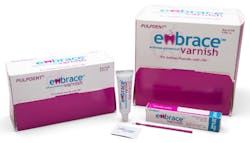Embrace Varnish: Timed-release fluoride varnish for superior caries prevention
By Amber Auger, RDH, MPH
Community water fluoridation is the single most effective public health measure to prevent tooth decay.(1) Early studies of Grand Rapids, Mich., fluoridated water demonstrated a decrease in tooth decay by 60% in babies and 40% in adults.(1) Today, there are thousands of products that offer fluoride. However, selecting a varnish that provides effective ingredients in a great-tasting time-released formula should be our standard of care.
History overview
Water fluoridation first began in the early 1940s, and toothpaste-containing fluoride was commercially available in 1954.(2) By end of the 1960s, 5% sodium fluoride varnish was researched to be the “new application method with a special long-lasting intensive fluoridating effect.”(3) Fluoride varnish has continued to improve for the ease of the clinician, with advanced science behind effective ingredients and improved taste for the patient.
Review of tooth decay
Dental caries involves demineralization that occurs in response to the diffusion into the enamel or dentin of acids produced by cariogenic bacteria, as they metabolize fermentable carbohydrates. Calcium and phosphate are the primary minerals that leak out from hydroxyapatite crystals during demineralization.(3)
Patients who have xerostomia have reduced or no access to calcium and phosphate from their saliva.(3) When demineralization is quicker than remineralization, subsurface lesions develop, leaving the patient with tooth decay. The appearance of a white spot lesion, known as demineralization, indicates sufficient subsurface mineral content has been lost; however, there is still potential for remineralization.(3) Remineralization of the tooth is possible with the reintroduction of calcium, phosphate, and fluoride.
Latest technology: 5% fluoride with cXp™ available in Embrace™ Varnish
When evaluating the dental caries process, we understand that the tooth loses calcium and phosphate when the oral pH is low. Therefore, adding these ingredients to fluoride treatments can enhance the beneficial effect for the patient. By incorporating xylitol-coated calcium and phosphate (cXp) in a permeable resin matrix, the ionic components in Embrace™ Varnish remain bioavailable. Also, the fluoride salts do not separate from the resin matrix, which ensures uniform dosage that is more effective than the average fluoride varnish, slowly releasing over four hours.(4)
Xyiltol offers a pleasing flavor while also preventing the calcium and phosphate salts from reacting until they come in contact with saliva.(5) The saliva dissolves the xylitol and activates the calcium and phosphate ions, which continue to interact with fluoride ions to form protective fluorapatite on the teeth.(5)
Review of Embrace Varnish
The slow release of bioavailable calcium and phosphate ions reinforces the benefits of the fluoride varnish, which continues working throughout the treatment period and helps reverse the effects of dietary sugars. Studies demonstrate that the four-hour cumulative fluoride release is superior in Embrace Varnish, releasing 10 times more fluoride than the leading brand.(5) There is no mixing required, which allows for an effective and uniform dose.(5)
The application of Embrace Varnish is simple. First, dry the teeth with a gauze pad. Next, pinch the varnish foil pack to push contents back from tear line and open the varnish pack. Dispense the varnish on the back of the glove and use the brush to pick up the varnish. Then, with a thin coat of the Embrace Varnish, apply the varnish with one horizontal swipe of the brush.
There are hundreds of products that offer fluoride. However, choosing a fluoride varnish with effective ingredients is paramount to decreasing patients’ risk of decay. As dental professionals, we are educators responsible for helping our patients have a healthier oral cavity with proper education and effective products. The slow release of xylitol-coated calcium and phosphate found in Pulpdent’s Embrace Varnish utilizes state of the art technology for supreme benefits.
References
- American Dental Association. Water Fluoridation Facts: Celebrating 60 Years of Water Fluoridation. 2015. Available at: http://www.ada.org/~/media/ADA/Member%20Center/FIles/fluoridation_facts.ashx. Accessed May 25, 2017.
- National Institute of Dental and Craniofacial Research. 2015. Available at: https://www.nidcr.nih.gov/OralHealth/Topics/Fluoride/TheStoryofFluoridation.htm. Accessed May 25, 2017.
- Collins, Fiona. The Development and Utilization of Fluoride Varnish. 2014. Available at: https://www.dentalacademyofce.com/courses/2093/PDF/1106cei_varnish_web4.pdf. Accessed May 25, 2017.
- Yapp R, Powers JM. Fluoride Ion Release from Several Fluoride Varnishes. Dental Advisor Res Rpt 45:1, March 2012.
- Pulpdent® Corporation. Embrace™. 2016. Available at: http://www.pulpdent.com/shop/category/embrace-varnish/. Accessed May 25, 2017.

